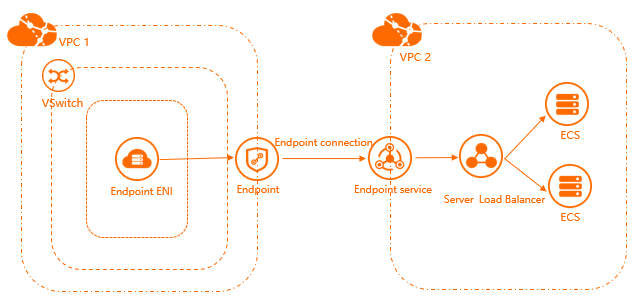This topic provides an overview of endpoints, and describes how to create an endpoint and use the endpoint to access an endpoint service.
Overview
You can associate an endpoint in a virtual private cloud (VPC1) with an endpoint service in another VPC (VPC2). This way, VPC1 can access the Server Load Balancer (SLB) instances in VPC2. Endpoints are created and managed by service consumers.
Procedure
Perform the following operations to create an endpoint and use the endpoint to access an endpoint service:

Create a vSwitch
Create a vSwitch. Make sure that the vSwitch is deployed in the zone of the SLB instances that serve as the service resources of the endpoint service. After the vSwitch is created, the system creates an endpoint elastic network interface (ENI) in the vSwitch. The endpoint ENI serves as an ingress for the VPC in which the endpoint is deployed to access the endpoint service.
Create an endpoint
Create an endpoint and associate the endpoint with the endpoint service. This way, the VPC in which the endpoint is deployed can access the SLB instances in the VPC in which the endpoint service is deployed. For more information, see the Create an endpoint section of the Create and manage endpoints topic.
View the domain name and IP address that can be used to access the endpoint service
After the endpoint is created, you can view the domain name and IP address that can be used to access the endpoint service. For more information, see the View the domain name or IP address that can be used to access an endpoint service section of the Create and manage endpoints topic.
Access the endpoint service
Access the endpoint service by using the domain name of the endpoint, the domain name of the zone in which the endpoint is deployed, or the IP address of the zone.